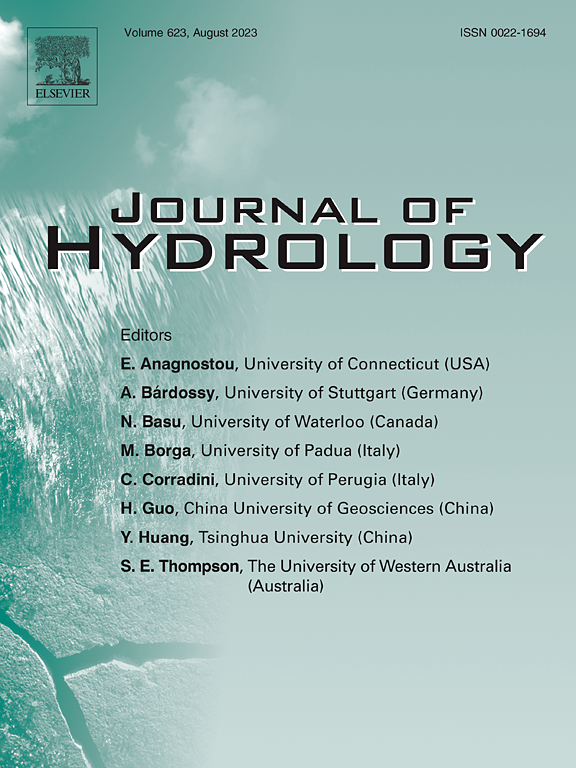Characterizing flash drought patterns in Eastern China based on high-resolution and long-term soil moisture fusion data
IF 5.9
1区 地球科学
Q1 ENGINEERING, CIVIL
引用次数: 0
Abstract
Influenced by global environmental change, the increasing flash droughts have raised the demand for reliable root zone soil moisture (SM) data for drought monitoring. However, existing model-based products exhibit uncertainties and limitations in accuracy and spatial resolution, in-situ or satellite datasets fail to provide long-term records for comprehensive flash drought analysis. This study has developed a high-resolution (0.0625°) Soil Moisture Integrated Fusion (SMIF) dataset spanning from 1979 to 2022 for flash drought analysis in Eastern China. The fusion framework is constructed by using an advanced LightGBM machine learning algorithm, integrating multi-source SM data including observations from 1321 in-situ stations, high-resolution and long-term land model simulation, and reanalyzed and satellite retrievals, as well as long-term auxiliary meteorological variables. Independent validation reveals a 25% to 88% improvement in KGE for temporal prediction accuracy compared to existing SM products at both site and regional scales, such as ERA5 and GLDASv2.1 reanalysis data. As a result, SMIF performs well in capturing spatiotemporal evolution of flash droughts, including Yangtze River mega flash drought events in 2013 and 2022. Compared with the 44-year SMIF dataset, ERA5 overestimates flash drought frequency by 48% in Sichuan Basin and 31% in Yangtze and Huai River basins, while GLDASv2.1 underestimates flash drought frequency by 49% in northern regions. The newly generated SMIF dataset effectively reduces the limitations of current root zone SM products in terms of accuracy, spatial resolution, and temporal coverage for flash drought characterization, which is useful for application in agriculture, water resource management, and environmental sustainability.
基于高分辨率和长期土壤水分融合数据的中国东部突发性干旱特征
受全球环境变化的影响,突发性干旱日益增多,对根系区土壤水分可靠数据的需求日益增加。然而,现有的基于模型的产品在精度和空间分辨率方面存在不确定性和局限性,原位或卫星数据集无法为全面的突发性干旱分析提供长期记录。本研究建立了1979 - 2022年高分辨率(0.0625°)土壤水分综合融合(SMIF)数据集,用于中国东部地区突发性干旱分析。融合框架采用先进的LightGBM机器学习算法,整合了1321个地面站观测数据、高分辨率和长期陆地模式模拟、再分析和卫星检索以及长期辅助气象变量等多源SM数据。独立验证表明,与现有的SM产品(如ERA5和GLDASv2.1再分析数据)相比,KGE在站点和区域尺度上的时间预测精度提高了25%至88%。结果表明,SMIF能较好地反映2013年和2022年长江特大特大干旱的时空演变特征。与44年SMIF数据相比,ERA5对四川盆地和长江、淮河流域的骤发干旱频率高估了48%,而GLDASv2.1对北方地区的骤发干旱频率低估了49%。新生成的SMIF数据集有效地降低了当前根区SMIF产品在暴发性干旱表征的精度、空间分辨率和时间覆盖方面的局限性,有助于农业、水资源管理和环境可持续性的应用。
本文章由计算机程序翻译,如有差异,请以英文原文为准。
求助全文
约1分钟内获得全文
求助全文
来源期刊

Journal of Hydrology
地学-地球科学综合
CiteScore
11.00
自引率
12.50%
发文量
1309
审稿时长
7.5 months
期刊介绍:
The Journal of Hydrology publishes original research papers and comprehensive reviews in all the subfields of the hydrological sciences including water based management and policy issues that impact on economics and society. These comprise, but are not limited to the physical, chemical, biogeochemical, stochastic and systems aspects of surface and groundwater hydrology, hydrometeorology and hydrogeology. Relevant topics incorporating the insights and methodologies of disciplines such as climatology, water resource systems, hydraulics, agrohydrology, geomorphology, soil science, instrumentation and remote sensing, civil and environmental engineering are included. Social science perspectives on hydrological problems such as resource and ecological economics, environmental sociology, psychology and behavioural science, management and policy analysis are also invited. Multi-and interdisciplinary analyses of hydrological problems are within scope. The science published in the Journal of Hydrology is relevant to catchment scales rather than exclusively to a local scale or site.
 求助内容:
求助内容: 应助结果提醒方式:
应助结果提醒方式:


